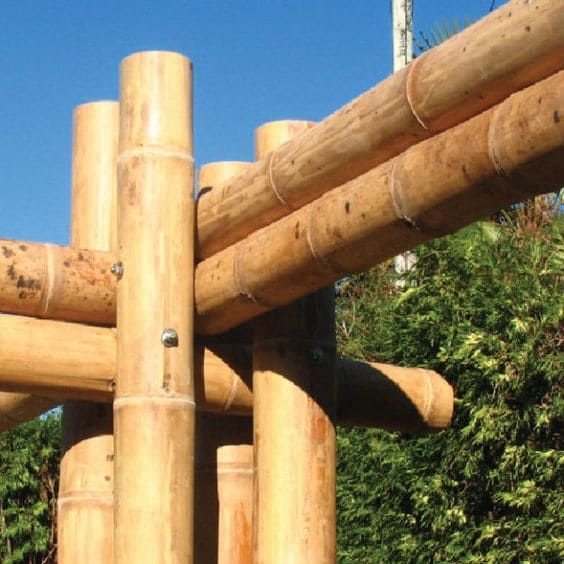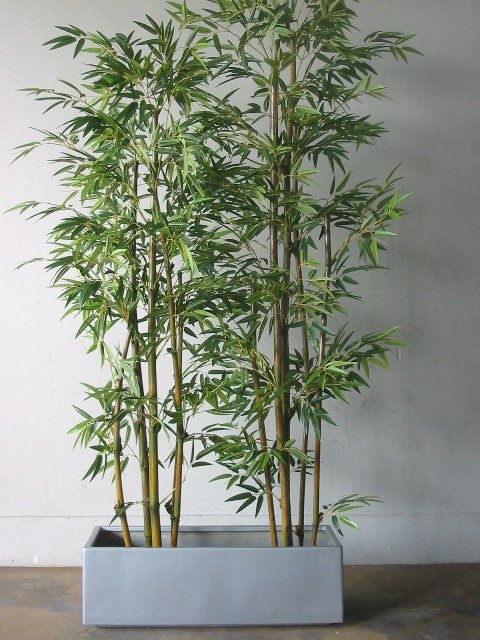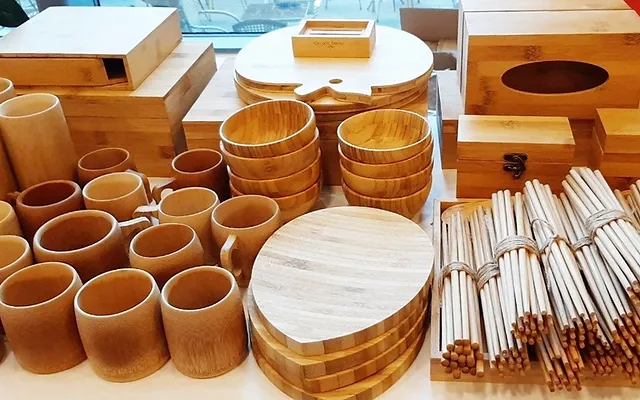How Much Weight Can Bamboo Hold?

0Shares
Bamboo may be used for scaffolding, bridges, houses, and offices as a construction material. Bamboo, like wood, is a natural composite material, which is suitable for structures with a high strength to weight ratio. The strength-to-weight ratio of Bamboo is comparable to wood, and its strength is typically equivalent to solid softwood or hardwood wood. Do you know how much weight can bamboo hold?
Bamboos are some of the most rapidly growing plants globally thanks to a special mechanism focused on the rhizome. Some bamboo species can grow 35 inches/89 cm within a 24-hour time frame, at a rate of approximately 0.00003 km / h (width about 1 mm (or 0.02 cm) every two minutes).
Historical Usage Of Building Bamboo
As a building material, Bamboo is historically connected to South Asia, East Asia, South Pacific, Central, and South America as a natural material. Bamboo has been used in China and India to carry simple suspension bridges, either by having split bamboo cables or twisting whole culms of sufficiently folding Bamboo together. One such bridge in the Qian-Xian region is mentioned in writings dating back to 960 AD and may have stood since the 3rd century BC largely because of ongoing maintenance.
Bamboo is long used as a scaffold; buildings over six floors in China are banned but continue to be used by skyscrapers in Hong Kong. In the Philippines, the nipa shed is a fairly traditional example of the most simple shed where Bamboo is used.
It has split walls with woven Bamboo, and it can be supported with bamboo slats and poles. Bamboo is used mostly as a supplementary and decorative feature in Japanese architecture in buildings like fences, fountains, rods, and gutters, mostly because of the ready supply of high-quality timber.
More Information
Bamboo is used in parts of India as a rod high up to the ceiling to carry clothes and stick with acquired know-how to hoist, spread and remove clothes if they are dry. It is also widely used as a ladder to hold bodies in funerals, aside from its usual purpose. The bamboo groves and forests of Maharashtra are called Veluvana.
The word Velu for Bamboo is most probably from Sanskrit, while Vana means forest. Bamboo is also used to create saffron-colored, Hindu flags of religion that float around India, particularly in Bihar and Uttar Pradesh.
Bamboo has become a crucial part of building culture in Central and South America. Vernacular types of housing, such as bahareque, have built using Bamboo in highly seismic areas. These were found to be remarkably well preserved and in good condition in earthquakes.
How Much Weight Can Bamboo Hold
Here’s what you should know about how much weight can bamboo hold.
1. Bamboo is powerful.
How much weight can bamboo hold? Bamboo fibers are 2-3 times stronger than wood relative to wood. Maple wood is one of the densest and strongest hardwoods, but Bamboo is thicker and lighter.
In Hong Kong, the abundance of bamboos, an amazingly strong structure, and lightweight combine to make it ideal for the skyscrapers to be constructed.
2. The strength of Bamboo comes from being rough.
Fortius Bamboo is 122% harder than Tasmanian Oak and performs on the market with almost every wood. It is no surprise that it is used for floors, walls, decks, plywood, clasps, and more besides the scaffolding.
The scale below is the extent to which Bamboo and those other woods have been tested for hardness in Janka, which measures resistance to the denture and wear. And the steel ball of 11.28 mm (0.444 inches) into the wood to half the ball’s diameter. As a result, Fortius Bamboo requires 3,000 pounds of force to do this.
3. Bamboo cable is stronger in some respects than steel.
The tensile strength of broken bamboo cables is as strong or stronger than the same size steel cable. When damp, hemp cables lose 20% of their strength, while bamboo cables increase their strength by 20% when wet. Bamboo is referred to in South America as vegetable steel.
The longest bamboo suspension bridge in China was built on the Min-Chiang River over 1000 years ago. During its damage, ferry boats were used, and the bridge was rebuilt in 1803. The bridge was 850 feet long, 9 foot wide, and ten woven bamboo cables with a diameter of 6 inches supported. A bamboo bridge could span almost 900 feet pretty wild.
Before we began to use steel to strengthen buildings, Bamboo remained the central component of building construction. Even today, Bamboo is used in buildings and other structures in underdeveloped areas.
Yet, most people have a distorted impression of Bamboo. People prefer to equate poor structures with Bamboo. But that’s not at all the case.
How Bamboo Overcomes Steel
How much weight can bamboo hold? Yeah, in terms of tensile strength, Bamboo is stronger than steel. Steel is 23,000 pounds tensile strength per square inch. Yet Bamboo exceeds steel with a marked lead of 28,000 pounds. Has the term tensile strength detected in the mix?
This is because there are variables to bear in mind when considering the strength of a material. The tensile strength can be defined as the strength provided by an object to tension break or split.
The Wondrous Bamboo Existence
The big thing about Bamboo is that we can use all parts of the plant for various purposes, from houses to deodorants and medicines. More than 490 bamboo species are available in the USA and Canada. Some bamboo species also have the fastest growing plant record.
It can grow above 3 feet per day and, depending on the species, achieve full maturity within 3 to 5 years.
One fact that is unknown about bamboo plants is that they release 30 percent more oxygen into the air than other plants, which is a good reason alone for them to thrive as the world faces increased air pollution and depletion of ozone. The plant also contributes to reducing soil erosion.
In a variety of applications, bamboo plants are used. The wood is used in homes, furnishings, bike frames, etc. Bamboo fibers, because of their antibacterial and temperature properties, are breathable and are used for clothes.
The bamboo carbon is an outstanding deodorant because of its absorptiveness.
Bamboo pieces are used in the food and medicinal items. Bamboo also enhances the taste of alcohol. These plants can grow anywhere and do not need fertilizers to grow. The plant’s dropped leaves have the necessary nutrients.
Bamboo As Alternative To Steel
For a long time, Bamboo was used in the building field well before its tensile strength was established. People were building homes, furniture, bamboo fences, etc. Because of its tensile properties, our modern researchers and engineers look forward to replacing steel with Bamboo.
Steel use in concrete is expensive, and steel manufacturing has many disadvantages, such as high costs, environmental contamination, and deterioration. On the other hand, Bamboo can be grown at very low costs and has many environmental advantages.
However, we cannot use Bamboo directly to replace steel as the tensile strength is not enough, even though Bamboo is found to be stronger and stronger than other building materials.
However, the plant is vulnerable to attack by insects and in the presence of water, will degrade. Long-term longevity and decline are also significant factors.
More Information
Extensive research is also underway to resolve all these limitations and to improve existing bamboo assets. These studies concentrate on the plant’s mechanical and physical characteristics and the finding of the most valuable organisms.
The wood of Bamboo is denser and heavier by MIT scientists and architects than woods such as spruce, fir, and pine. They are trying to use Bamboo’s properties to make it a stronger construction material that can be used to build more durable buildings.
Bamboo And Technology
The use of Bamboo, also known as ‘poor man’s wood,’ is also numerous in engineering. Conservation groups promote bamboo because of its diversity of excellent properties and its capacity to emit oxygen.
Its high tensile strength, compression resistance, and bending properties make it a very promising building material. Designers use bamboo as an alternative to timber.
The wooden bamboo panels provide a natural look and finish. Bamboo floors, cabinets, and household objects are longer lasting and cheaper.
When scientists weavened epoxy bamboo, they ended up with a compound stronger than carbon fiber. This gives us the hope that Bamboo will one day be used as an alternative to carbon fiber.
The biggest benefit is that it is 100 times cheaper than carbon fiber. Bamboo’s low cost, large availability, and strength allowed this plant to be used to construct shelters and major relief projects for disasters.
Final Words
Bamboo’s use will reduce the need for materials such as steel, plastic things, carbon fiber, and so on in the building, car, and other potential sectors. In exchange, this decreases greenhouse gas emissions to a large degree. The low bamboo cost lowers the total building cost and makes it affordable for everyone.
Another essential benefit of bamboo processing is that no part of the plant is lost. It is a good idea, taking these facts into account, to encourage the growth and usage of Bamboo to ensure lower living costs and a healthier climate for our future generations.
0Shares






